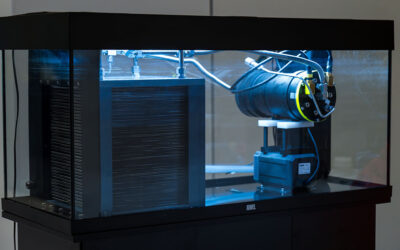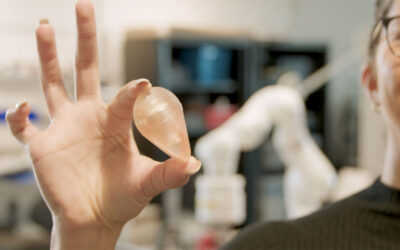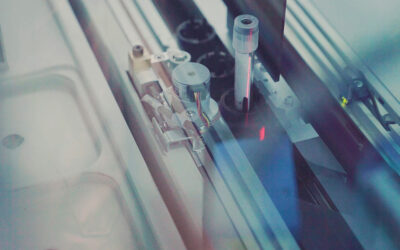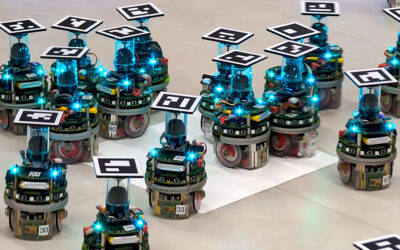Scientists have designed robotic wings that take after those of butterflies. They rely on magnetic fields to move without bulky electronic components or batteries while mimicking the natural movement of butterflies.
“Monarch butterflies’ remarkable migratory abilities and their highly efficient, adaptable wing structures inspired our design,” said Muhammad Khan from Technical University Darmstadt in Germany.
Monarch butterflies are known for their striking endurance. Every year, they travel thousands of kilometers as they migrate from Canada to Mexico in the fall, just to head back north again in the spring. This is possible thanks to the natural structure of their wings, which makes them lightweight, flexible, and excellent at flying — a unique combination the researchers wanted to mimic in their robots.
This design could enable scientists to make much smaller flying robots, allowing them to move with more precision and access narrow spaces while keeping their energy requirements low.
“The magnetic butterflies could be used for environmental monitoring, such as pollination studies, or as educational tools,” said Khan. “Their lightweight and energy-efficient design will also make them promising for micro aerial vehicles used in search-and-rescue missions.”
Building magnetic butterflies
Despite their small size, the natural design of monarch butterfly wings is very sophisticated, having evolved to withstand extremely long journeys. One of the fundamental principles that makes these wings so efficient during flight is that they don’t just create thrust by actively moving, but also by passively bending their natural shape, which allows them to ‘glide’ without spending additional energy.
To replicate this, the researcher team, led by Oliver Gutfleisch at TU Darmstadt and Denys Makarov at Helmholtz Zentrum Dresden-Rossendorf, built the robotic butterfly wings by embedding magnetic particles into a flexible plastic material.
“The wings are made from a magnetic composite material that responds to external magnetic fields,” said Kilian Schäfer, co-author of the study. “When a magnetic field is applied, the embedded magnetic particles cause the wings to bend or deform, mimicking the movement of real butterfly wings.”
Using 3D printing, they created 12 different wing designs with different sizes to test their behavior using a mix of experimental tests and computer simulations. Some of the designs also recreated vein patterns in their design that mimicked those found in monarch butterfly wings to test if these structures could improve their performance.
What they found was that larger wings — about 28 mm long — with vein patterns were less stiff and easier to bend, making them better at adapting their shape during flight.
In their tests, the scientists also found that butterflies that were 3D printed using higher energy laser settings were thinner and better at bending. However, they were also more fragile and prone to damage.
“The biggest challenge was fabricating thin, flexible structures with embedded vein patterns” that were still functional while being less than a millimeter thick, said Schäfer. “Ensuring that these features remained intact (…) required fine-tuning the 3D printing process, particularly the laser energy settings, to achieve the desired mechanical properties.”
Lighter, better robots
The unique design of the magnetic robots makes them able to function without any electronic components, which typically limit how small and lightweight flying robots can be.
“Compared to traditional flying robot designs, (…) our approach offers flexibility, reduced weight, and the ability to achieve complex, naturalistic wing movements,” said Khan.
In addition to being used as micro aerial vehicles, the butterfly-inspired robots could have applications in biomedical devices like remotely operated surgical tools, and environmental monitoring systems.
“Additionally, it could inspire new designs for artificial muscles and shape-morphing components in other fields,” he said.
So far, the researchers focused on studying one type of wing movement that is crucial for lifting and generating thrust in monarch butterflies. More work will be needed to replicate all the different movements required for flight.
The next steps will involve exploring the performance of the wings under different types of magnetic fields, including fields that change direction over time to control the wing movements forward and backward. Further research and development will allow them to optimize the wing design for real-world flight applications.
“Currently, the wings are limited by their need for external magnetic fields. Future work could focus on integrating more miniaturized magnetic field generators with feedback control for autonomous operation,” said Khan. This could enable the robots to eventually move and act without human input.
“We are also interested in applying similar bioinspired design principles to develop other shape-morphing robotic systems, particularly for applications requiring high adaptability and efficiency.”
Reference: Muhammad Bilal Khan, Kilian Schäfer et al., Bioinspired Design, Fabrication, and Wing Morphing of 3D Printed Magnetic Butterflies, Advanced Intelligent Systems (2024). DOI: aisy.202400620

















